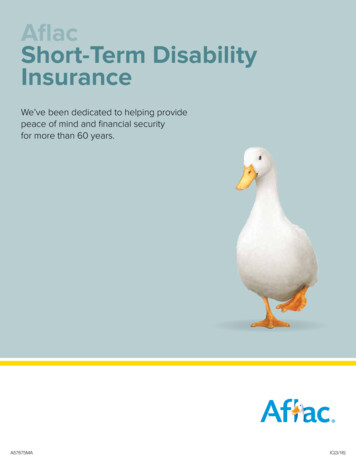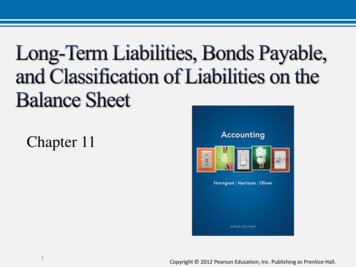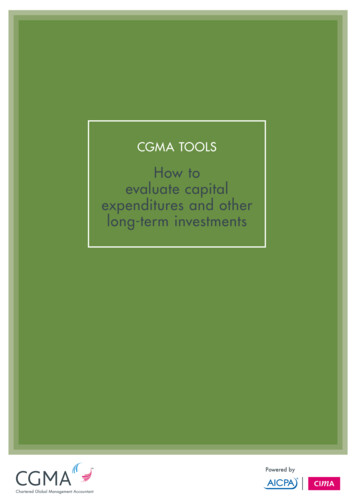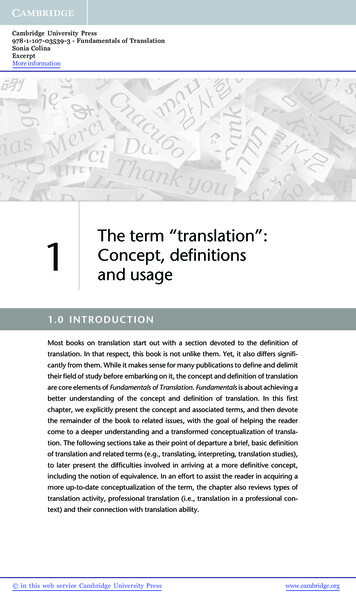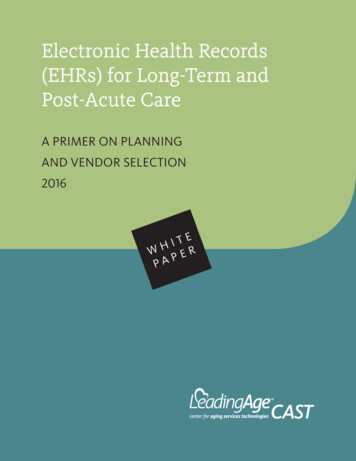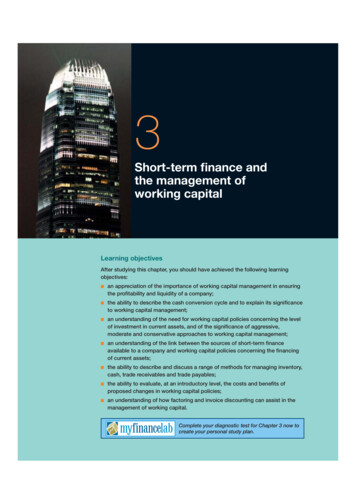
Transcription
3Short-term finance andthe management ofworking capitalLearning objectivesAfter studying this chapter, you should have achieved the following learningobjectives: an appreciation of the importance of working capital management in ensuringthe profitability and liquidity of a company; the ability to describe the cash conversion cycle and to explain its significanceto working capital management; an understanding of the need for working capital policies concerning the levelof investment in current assets, and of the significance of aggressive,moderate and conservative approaches to working capital management; an understanding of the link between the sources of short-term financeavailable to a company and working capital policies concerning the financingof current assets; the ability to describe and discuss a range of methods for managing inventory,cash, trade receivables and trade payables; the ability to evaluate, at an introductory level, the costs and benefits ofproposed changes in working capital policies; an understanding of how factoring and invoice discounting can assist in themanagement of working capital.Complete your diagnostic test for Chapter 3 now tocreate your personal study plan.M01 WATS5251 05 SE C03.indd 6911/14/09 4:07:40 PM
Chapter 3 Short-term finance and the management of working capitalIntroductionLong-term investment and financing decisions give rise to future cash flows which, whendiscounted by an appropriate cost of capital, determine the market value of a company.However, such long-term decisions will only result in the expected benefits for a company ifattention is also paid to short-term decisions regarding current assets and liabilities. Currentassets and liabilities, that is, assets and liabilities with maturities of less than one year, needto be carefully managed. Net working capital is the term given to the difference betweencurrent assets and current liabilities: current assets may include inventories of raw materials,work-in-progress and finished goods, trade receivables, short-term investments and cash,while current liabilities may include trade payables, overdrafts and short-term loans.The level of current assets is a key factor in a company’s liquidity position. A company must have or be able to generate enough cash to meet its short-term needs if itis to continue in business. Therefore, working capital management is a key factor inthe company’s long-term success: without the ‘oil’ of working capital, the ‘engine’ ofnon-current assets will not function. The greater the extent to which current assetsexceed current liabilities, the more solvent or liquid a company is likely to be,depending on the nature of its current assets.3.1 The objectives of working capital managementTo be effective, working capital management requires a clear specification of theobjectives to be achieved. The two main objectives of working capital management areto increase the profitability of a company and to ensure that it has sufficient liquidityto meet short-term obligations as they fall due and so continue in business (Pass andPike 1984). Profitability is related to the goal of shareholder wealth maximisation, soinvestment in current assets should be made only if an acceptable return is obtained.While liquidity is needed for a company to continue in business, a company maychoose to hold more cash than is needed for operational or transaction needs, forexample for precautionary or speculative reasons. The twin goals of profitability andliquidity will often conflict since liquid assets give the lowest returns. Cash kept in asafe will not generate a return, for example, while a six-month bank deposit will earninterest in exchange for loss of access for the six-month period.3.2 Working capital policiesBecause working capital management is so important, a company will need to formulateclear policies concerning the various components of working capital. Key policy areas relateto the level of investment in working capital for a given level of operations and the extentto which working capital is financed from short-term funds such as a bank overdraft.A company should have working capital policies on the management of inventory, tradereceivables, cash and short-term investments in order to minimise the possibility of70M01 WATS5251 05 SE C03.indd 7011/14/09 4:07:41 PM
Working capital policiesmanagers making decisions which are not in the best interests of the company. Examplesof such suboptimal decisions are giving credit to customers who are unlikely to pay andordering unnecessary inventories of raw materials. Sensible working capital policieswill reflect corporate decisions on: the total investment needed in current assets, i.e. theoverall level of investment; the amount of investment needed in each type of current asset,i.e. the mix of current assets; and the way in which current assets are to be financed.Working capital policies need to consider the nature of the company’s businesssince different businesses will have different working capital requirements. A manufacturing company will need to invest heavily in spare parts and components andmight be owed large amounts of money by its customers. A food retailer will havelarge inventories of goods for resale but will have very few trade receivables. Themanufacturing company clearly has a need for a carefully thought out policy onreceivables management, whereas the food retailer may not grant any credit at all.Working capital policies will also need to reflect the credit policies of a company’s closecompetitors, since it would be foolish to lose business because of an unfavourablecomparison of terms of trade. Any expected fluctuations in the supply of or demand forgoods and services, for example due to seasonal variations in business, must also be considered, as must the impact of a company’s manufacturing period on its current assets.3.2.1 The level of working capitalAn aggressive policy with regard to the level of investment in working capital meansthat a company chooses to operate with lower levels of inventory, trade receivablesand cash for a given level of activity or sales. An aggressive policy will increaseprofitability since less cash will be tied up in current assets, but it will also increaserisk since the possibility of cash shortages or running out of inventory is increased.A conservative and more flexible working capital policy for a given level of turnoverwould be associated with maintaining a larger cash balance, perhaps even investing inshort-term securities, offering more generous credit terms to customers and holdinghigher levels of inventory. Such a policy will give rise to a lower risk of financialproblems or inventory problems, but at the expense of reducing profitability.A moderate policy would tread a middle path between the aggressive and conservativeapproaches. All three approaches are shown in Figure 3.1.It should be noted that the working capital policies of a company can be characterised as aggressive, moderate or conservative only by comparing them with theworking capital policies of similar companies. There are no absolute benchmarksof what may be regarded as aggressive or otherwise, but these characterisations areuseful for analysing the ways in which individual companies approach the operationalproblem of working capital management.3.2.2 Short-term financeShort-term sources of finance include overdrafts, short-term bank loans and trade credit.An overdraft is an agreement by a bank to allow a company to borrow up to acertain limit without the need for further discussion. The company will borrow as much71M01 WATS5251 05 SE C03.indd 7111/14/09 4:07:41 PM
Chapter 3 Short-term finance and the management of working capitalFigure 3.1 Different policies regarding the level of investment in working capitalor as little as it needs up to the overdraft limit and the bank will charge daily interest ata variable rate on the debt outstanding. The bank may also require security or collateralas protection against the risk of non-payment by the company. An overdraft is a flexiblesource of finance in that a company only uses it when the need arises. However, anoverdraft is technically repayable on demand, even though a bank is likely in practiceto give warning of its intention to withdraw agreed overdraft facilities.A short-term loan is a fixed amount of debt finance borrowed by a company froma bank, with repayment to be made in the near future, for example after one year.The company pays interest on the loan at either a fixed or a floating (i.e. variable)rate at regular intervals, for example quarterly. A short-term bank loan is less flexiblethan an overdraft, since the full amount of the loan must be borrowed over the loanperiod and the company takes on the commitment to pay interest on this amount,whereas with an overdraft interest is only paid on the amount borrowed, not on theagreed overdraft limit. As with an overdraft, however, security may be required as acondition of the short-term loan being granted.Trade credit is an agreement to take payment for goods and services at a later date thanthat on which the goods and services are supplied to the consuming company. It is commonto find one, two or even three months’ credit being offered on commercial transactionsand trade credit is a major source of short-term finance for most companies.Short-term sources of finance are usually cheaper and more flexible than long-termones. Short-term interest rates are usually lower than long-term interest rates, for example,and an overdraft is more flexible than a long-term loan on which a company is committed to pay fixed amounts of interest every year. However, short-term sources offinance are riskier than long-term sources from the borrower’s point of view in thatthey may not be renewed (an overdraft is, after all, repayable on demand) or may berenewed on less favourable terms (e.g. when short-term interest rates have increased).Another source of risk for the short-term borrower is that interest rates are more volatile in the short term than in the long term and this risk is compounded if floatingrate short-term debt (such as an overdraft) is used. A company must clearly balance72M01 WATS5251 05 SE C03.indd 7211/14/09 4:07:41 PM
Working capital policiesprofitability and risk in reaching a decision on how the funding of current and noncurrent assets is divided between long-term and short-term sources of funds.3.2.3 Financing working capitalThe trade-off between risk and return which occurs in policy decisions regardingthe level of investment in current assets is also significant in the policy decisionon the relative amounts of finance of different maturities in the balance sheet, i.e. onthe choice between short- and long-term funds to finance working capital. To assistin the analysis of policy decisions on the financing of working capital, we can divide acompany’s assets into three different types: non-current assets, permanent current assetsand fluctuating current assets (Cheatham 1989). Non-current assets are long-termassets from which a company expects to derive benefit over several periods, forexample factory buildings and production machinery. Permanent current assetsrepresent the core level of investment needed to sustain normal levels of businessor trading activity, such as investment in inventories and investment in the averagelevel of a company’s trade receivables. Fluctuating current assets correspond to thevariations in the level of current assets arising from normal business activity.A matching funding policy is one which finances fluctuating current assets with shortterm funds and permanent current assets and non-current assets with long-term funds.The maturity of the funds roughly matches the maturity of the different types of assets.A conservative funding policy uses long-term funds to finance not only non-currentassets and permanent current assets, but some fluctuating current assets as well. Asthere is less reliance on short-term funding, the risk of such a policy is lower, butthe higher cost of long-term finance means that profitability is reduced as well. Anaggressive funding policy uses short-term funds to finance not only fluctuating currentassets, but some permanent current assets as well. This policy carries the greatestrisk to solvency, but also offers the highest profitability and increases shareholdervalue. These three funding policies are illustrated in Figure 3.2.Figure 3.2 The (a) matching, (b) conservative and (c) aggressive approaches to the relativeproportions of the long- and short-term debt used to finance working capital73M01 WATS5251 05 SE C03.indd 7311/14/09 4:07:41 PM
Chapter 3 Short-term finance and the management of working capital3.3 Working capital and the cash conversion cycleWorking capital can be viewed statically as the balance between current assets andcurrent liabilities, for example by comparing the balance sheet figures for inventory,trade receivables, cash and trade payables. Alternatively, working capital can be vieweddynamically as an equilibrium between the income-generating and resource-purchasingactivities of a company (Pass and Pike 1984), in which case it is closely linked to thecash conversion cycle (see Section 2.4.4).The cash conversion cycle, which represents the interaction between the componentsof working capital and the flow of cash within a company, can be used to determinethe amount of cash needed for any sales level. It is the period of time between theoutlay of cash on raw materials and the inflow of cash from the sale of finishedgoods, and represents the number of days of operation for which financing is needed.The longer the cash conversion cycle, the greater the amount of investment requiredin working capital. The length of the cash conversion cycle depends on the length of: the inventory conversion period;the trade receivables collection period;the trade payables deferral period.The inventory conversion period is the average time taken to use up raw
Working capital policies will also need to reflect the credit policies of a company’s close competitors, since it would be foolish to lose business because of an unfavourable comparison of terms of trade. Any expected fluctuations in the supply of or demand for goods and services, for example due to seasonal variations in business, must also be con- sidered, as must the impact of a company .

